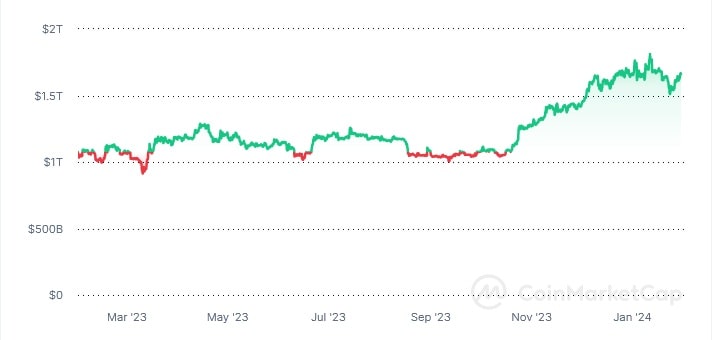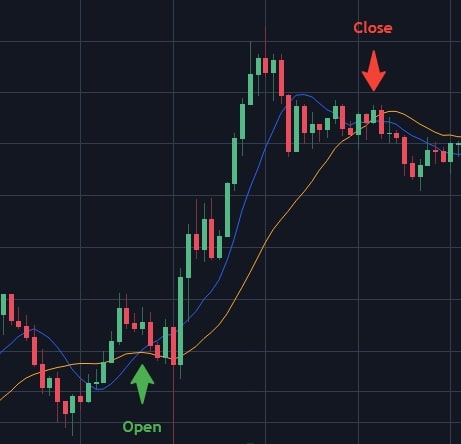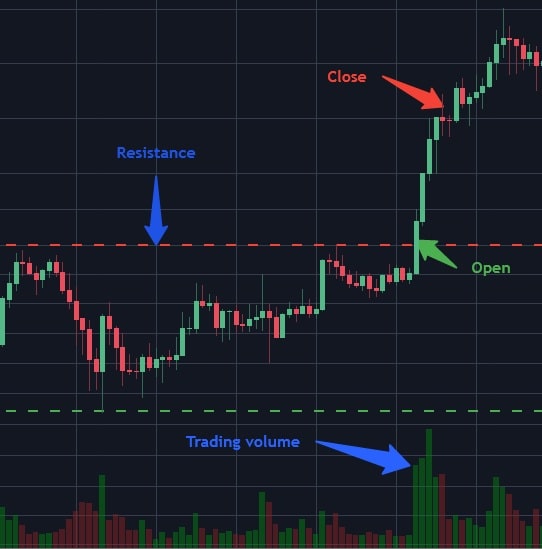Trading Strategy to Grow Your Crypto Portfolio in 2024

2024 brings fresh perspectives and potential breakthroughs, making it an exciting time for crypto enthusiasts. Crypto trading still remains one of the most lucrative methods of making money from cryptocurrencies. If you're aiming to enhance the growth of your crypto portfolio through trading, this article is your guide. It will tell you which trading strategies may be promising for the crypto market in 2024, as well as how to diversify your crypto portfolio.
Is 2024 the new era of cryptocurrency trading?
Trading is the hardest way to make an easy dollar. — Dr Alexander Elder.
It's hard to say whether 2024 can be called the new era of crypto trading. Nevertheless, the crypto market continues to evolve and reach new levels of maturity. Increased institutional participation, regulatory clarity, the development of blockchain technology, and the continued mass adoption of cryptocurrencies will certainly play a role in the further evolution of crypto trading.
Will crypto rise in 2024?
Although this question cannot be answered with certainty, many signs point to 2024 being a favourable year for cryptocurrencies. After a rather long sideways movement in 2023, the crypto market is showing a clear bullish trend. Of course, we are likely to see price corrections, perhaps even quite deep, but the overall outlook at the moment is optimistic. Thus, in 2024, the crypto market is likely to offer investors many opportunities for building a crypto portfolio.

What is a crypto trading strategy?
A crypto trading strategy is a set of rules that a trader follows to make decisions about buying and selling cryptocurrencies in the market. Trading strategies can be simple or complex, but in any case, a properly designed trading strategy tells the trader what triggers the opening of a position, what triggers the closing of a position, what size the position should be and where the Stop Loss should be placed.
Why is a crypto trading strategy necessary?
A trading strategy is an essential tool for a trader, without which it's virtually impossible to achieve any sustainable profitability of trading. A proper trading strategy provides a structured framework for decision-making and is crucial for managing risks, maintaining emotional discipline, and optimising entry and exit points. Trading without a strategy is effectively gambling, not actual trading.
Top crypto trading strategies in 2024
Trading in bull markets is relatively easy compared to bear markets. There are many trading strategies that are effective in a bull market. While there is no single best crypto trading strategy for a bull market, let's take a look at some of the most popular ones.
Hodling
Hodling or "Buy and Hold" cannot be called a full-fledged trading strategy. However, it can be quite effective in a bullish market, and its simplicity makes it very popular. "Hodling" is a term derived from a misspelling of "holding" and has become a popular meme and philosophy within the cryptocurrency community. It refers to the practice of holding onto cryptocurrencies for the long term, regardless of short-term market fluctuations.
The most effective way to use this strategy is to hold a position for the duration of a global bullish trend and close it when the trend changes to a bearish one.

Trend following
Trend following is a simple trading approach that involves identifying and capitalising on existing market trends. The core principle of this approach is to align trades with the prevailing direction of the market. Traders use technical analysis tools to identify the direction of the market trend and enter positions in the direction of the established trend. Breakouts or pullbacks within the trend are often considered opportune entry points.
The primary goal is to stay in the trade as long as the trend persists. Traders seek to ride the momentum and capture as much price movement as possible. Simple or trailing Stop Loss orders are used to limit potential losses in the event of a trend reversal. Common exit signals may include trend reversals, crossing moving averages, or touching a resistance level.

Breakout trading
Breakout trading is a strategy that involves opening positions when the price breaks through a resistance or support level. The strategy is based on the idea that once the price breaks through a key level, it's likely to continue moving in the same direction. In a bullish market, traders should focus on upside breakouts.
When using this strategy on a bullish market, traders look for horizontal or diagonal resistance levels. After a breakout, traders wait for its confirmation, which usually comes in the form of a candle closing above (for a bullish breakout) a key level. Once the breakout is confirmed, traders enter the trade in the direction of the breakout. Stop Loss orders for bullish breakouts are typically placed just below the breakout level. Target prices are set based on the expected extent of the price movement following the breakout.
It's important to keep in mind the possibility of false breakouts when the price briefly goes beyond the key level but then reverses. A typical sign of a false breakout is a low trading volume at the moment of the breakout.

Pullback trading
Pullback trading is a strategy that involves opening positions in the direction of the prevailing trend when the price experiences a temporary retracement. The key idea is to enter trades at favourable prices during a trend, capitalising on the belief that the trend will resume after the pullback. In a bullish market, traders should look for buying opportunities on pullbacks.
Pullback traders begin by identifying an established trend and wait for the price to experience a retracement against the prevailing trend. Before opening a position, traders look for confirmation that the pullback is likely to be temporary and that the overall trend is still intact. This confirmation could come from technical indicators, chart patterns, or other analysis tools.
Once the pullback is confirmed, traders enter the trade in the direction of the prevailing trend. Stop Loss orders are typically placed below (for a bullish pullback) or above (for a bearish pullback) the recent low or high of the pullback. Target prices are set based on the expected continuation of the trend. This could be determined by measuring the distance between recent swing highs and lows or using other technical analysis methods.
Some traders use Fibonacci retracement levels to identify potential levels of support or resistance during a pullback.
Building a solid foundation
For a crypto investor, trading strategies are only part of the path to success. On top of that, one needs to learn how to make and manage a crypto portfolio.
Setting investment goals
Venturing into investing without setting goals is like embarking on a journey without knowing where you want to get to. Understanding what you aim to achieve provides direction to your trading strategy and helps you stay focused.
- Defining short-term and long-term objectives. Clearly articulate your short-term goals, which might include capitalising on market volatility or taking advantage of specific trends. Establish long-term objectives, such as wealth accumulation or portfolio growth, to guide your overall investment strategy.
- Risk tolerance and capital allocation. Assess your risk tolerance level to determine how much risk you're comfortable taking on in your crypto investments. Establish a clear capital allocation plan, ensuring that you don't expose more than you can afford to lose in any single trade.
- Measuring success. Identify key performance indicators to measure the success of your trading strategy. Regularly review and reassess your goals as the market landscape evolves.
Diversification strategies for cryptocurrency portfolios in 2024
Portfolio diversification is a time-tested risk management technique that aims to spread risk across various assets, reducing the impact of poor performance in any single investment.
- Risk-based diversification. It's a portfolio strategy that involves allocating investments based on an individual's risk tolerance and the desire to manage overall portfolio risk. The goal is to spread investments across different assets or asset classes with various risk profiles, creating a balanced portfolio that aligns with the investor's risk preferences.
- Asset class diversification. It's a strategy that involves spreading investments across different categories of assets to manage risk and enhance the overall stability of a portfolio. This approach recognises that different asset classes have unique risk-return profiles, and by diversifying, investors aim to achieve a more balanced and resilient investment portfolio. Examples of such classes are Bitcoin as the first and largest cryptocurrency, DeFi tokens, private coins such as Monero (XMR) or Zcash (ZEC), Layer-2 scaling solutions, tokens associated with different blockchain platforms, such as Cardano's ADA or Polkadot's DOT, etc.
- Market cap-based diversification. It's a strategy that involves allocating investments across different cryptocurrencies based on their market capitalisation. Large-cap cryptocurrencies are generally associated with lower risk and lower potential returns, while small-caps carry higher risk and the potential for higher returns. Balancing the portfolio across market cap segments allows investors to manage risk and pursue diverse opportunities.
- Time horizon-based diversification. It's a strategy that involves adjusting a portfolio composition based on the investor's specific time horizon or the anticipated holding period for their investments.
- Cross-asset diversification. Consider diversification not only within the cryptocurrency market but also across traditional assets like stocks, bonds, and commodities. This broader approach can help reduce overall portfolio risk, especially during times of market turbulence.
Tags
Try our Bitcoin Cloud Miner and get additional crypto rewards based on your trading volume. It's immediately available upon registration.
Try our Bitcoin Cloud Miner and get additional crypto rewards based on your trading volume. It's immediately available upon registration.



